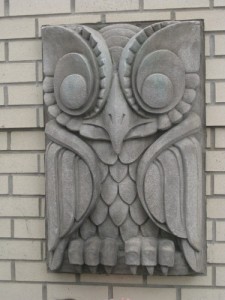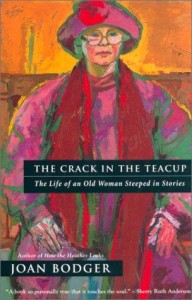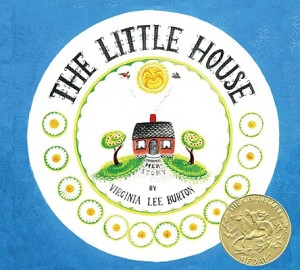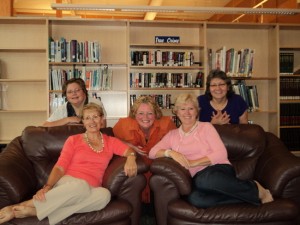June 5, 2012
Library Owl
 While I am quite familiar with the griffin and the lion flanking the entrance to the Lillian H. Smith Library, it was only today that I discovered the owl. It’s on the front of the building toward the west end, sort of hidden behind a sign on the sidewalk and I’d never noticed it before as I charged along the sidewalk, stroller in hand, hurrying home in time for lunch and nap-time. But Harriet has taken to walking, and as a result, our routes along the sidewalk have become much more meandering. Which is kind of annoying, but how brilliant when it yields a treasure. I have no doubt that wandering with Harriet will improve my city sight.
While I am quite familiar with the griffin and the lion flanking the entrance to the Lillian H. Smith Library, it was only today that I discovered the owl. It’s on the front of the building toward the west end, sort of hidden behind a sign on the sidewalk and I’d never noticed it before as I charged along the sidewalk, stroller in hand, hurrying home in time for lunch and nap-time. But Harriet has taken to walking, and as a result, our routes along the sidewalk have become much more meandering. Which is kind of annoying, but how brilliant when it yields a treasure. I have no doubt that wandering with Harriet will improve my city sight.
And just when I thought the Lillian H. Smith Library couldn’t be any more wonderful…
More: Joan Bodger and the Lillian H. Smith Library (see final paragraphs)
February 9, 2012
Of Myths and Mad Men: Rereading Joan Bodger's The Crack in the Teacup
 It was only two years ago that I first read Joan Bodger’s The Crack in the Teacup, but revisiting it was an experience that was altogether new. First, because my interest in children’s literature has become so much deeper since then (mostly due to what I learned from reading this book the first time, and from Bodger’s other book How the Heather Looks) and also because of Mad Men. But we’ll get to that.
It was only two years ago that I first read Joan Bodger’s The Crack in the Teacup, but revisiting it was an experience that was altogether new. First, because my interest in children’s literature has become so much deeper since then (mostly due to what I learned from reading this book the first time, and from Bodger’s other book How the Heather Looks) and also because of Mad Men. But we’ll get to that.
I do think that A Crack in the Teacup might be one of my favourite books ever. I read it over five days last week, and absolutely would not shut up about it. You will see. The beginning is a little slow, if only because Bodger’s childhood is spent at a remove from the rest of the world. Which is what makes it interesting of course, but she examines it in such minute detail, perhaps because these details of a happy time are so much more pleasant to examine than what comes later.
I think it is inevitable that one becomes a storyteller when one can write about her grandfather’s first wife who was killed in a shipwreck in 1877. Really, all the ingredients here are the stuff of storybooks: her mother is English, the daughter of a sailor whose third wife is a quarter Chinese, who grows up in a stately home surrounded by books but no schooling, spends her teenage years crippled after being flung from a horse, and then recovers enough to drive an ambulance during WW1 (without a license). She marries an American at the end of the War, moves across the sea, and has three daughters (with Bodger in the middle). Her husband joins the US coast guard chasing rum runners and leading ships out of Arctic ice after failed polar expeditions, and they spend the ’20s and ’30s moving up and down east and west coasts.
It was a happy enough childhood, rich with stories and lore, but also an isolated one. Bodger’s immigrant mother held herself apart from American society, and that the family moved around so much didn’t help matters. From early on, Bodger had a hard time fitting in, accepting authority, understanding how the world worked outside the Higbee family. There was also so much that was never talked about– her mother’s health problems, father’s infidelities, her own burgeoning sexuality, her yearning for the education her father didn’t feel was necessary for a daughter to have. Bodger and her sisters were being groomed to be ladies, roles none of them would easily fulfil.
Bodger’s college plans are diverted by WW2, she joins the army, and becomes a bumbling decoder (“I put my hand in the grab bag and pulled out a message about a place spelled Yalta. Obviously a mistake! I changed the Y to M.”) She goes back to school once the war is finished, and meets John Bodger, a graduate student and fellow veteran. She’s head over heels, and without a doubt that their life together will be a happy one as he completes his PhD (with her love and support, of course), and becomes internationally recognized as the brilliant mind he obviously is.
Which is where Mad Men comes into play. Apart from a few years in California, the Bodgers spend the ’50s and early ’60s living in and around Westchester County NY, which is Cheever-country, the world of Mad Men. And though the Bodgers could not pretend to be the cookie cutter figures their suburban surroundings suggested, it”s the same backdrop, healthy kids and big green lawns, the war in the past now, educated mothers idle in the afternoons, philandering husbands, cracks becoming apparent in all kinds of veneers. It soon becomes apparent that not all is right with John Bodger: he struggles to hold down a job at all, has to give up his academic aspirations, begins to display signs of paranoia. Joan Bodger makes life-long connections with the women in her neighbourhood, many of whom have similary troubled marriages and dissatisfaction with their lives. But she doesn’t connect with all her neighbours:
“Bette told me that another woman in the neighbourhood was writing a book– a sort of update to Virginia Woolf’s A Room of One’s Own. Her name was Betty Friedan. She lived just down the street from us; her little girl was in Lucy’s class. I telephoned her. I felt silly doing it, yet I longed to talk shop with someone. How do you manage to write with kids around? Betty Friedan said she was too busy to talk to every suburban housewife who called her.”
The book Bodger was writing, of course, was How the Heather Looks, the story of a trip her family takes to England in 1958 to rediscover worlds they only knew from storybooks, to make end paper maps come alive. A book whose portrayal of ideal family life belies the real story of her family– John Bodger would be diagnosed with schizophrenia, he and Joan would eventually divorce. Before their divorce, their daughter Lucy would die of a brain tumour, and their son Ian would battle his own demons, with mental illness and drug addiction. And throughout these tragedies, it is Bodger’s faith in story that enables her to survive. And not neat stories either, with beginnings, middle and ends, but rather the dark archetypal stories with no end that occur over and over in cultures all around the world, and which give our own experiences depth and meaning, that help us to understand the things that happen to us in our lives.
But story, of course, is useful in a more practical sense as well. Eager for diversions after Lucy’s death, Bodger becomes involved in an education program to promote graduation rates for black students in her town of Nyack NY. She realizes that although she lives in the very same town, she knows nothing about the lives of the black people around her. She starts sitting on the steps of a church in the black neighbourhood, armed with candy and picture books to give away (because by this time, she’s become a children’s book reviewer, and has plenty of review copies to spare), ready to make some connections. She quickly discerns that the picture books she’s brought are useless– they reflect nothing of the lives of the children she’s trying to reach, and many of the children don’t know how to relate to or connect with a book anyway. So she starts telling stories instead, and she’s good at it. Eventually a police man contacts her and says he’s concerned she’s going to stop telling stories when the weather gets cold. He’s with the NAACP and they want to help her out– could they get her an indoor place where the children can go to hear her?
Bodger uses what she learns from this experience to set up a free nursery school in the neighbourhood, and continues to learn about what children’s literature can do. She writes about the impact of black children seeing somebody like themselves in storybooks for the first time in Ezra Jack Keats’ A Snowy Day, and about her own conversations with Keats about resisting their liberal impulses and acknowledging the childrens’ race. (“Not until we gave ourselves permission to see their blackness could these children give themselves permission to see themselves.”) Similarly about the powers of books like Where the Wild Things Are and A Apple Pie to encourage children to express their own feelings of rage, anger and aggression. To begin to tell stories themselves, to make the stories their own.
Her husband and son drift far away from her as she becomes more involved in early literacy and storytelling. Eventually Bodger leaves New York and for short time works for the library association of Missouri (where her ability to make waves is less accepted than it had been in New York, and she is eventually dismissed from her job, somewhat farfetchedly, for being “a communist pornographer” [and her second husband would jokingly complain of the false advertising of that title]). She head back east and works in editing and consulting for Random House, though still shell-shocked and heartbroken by the tragedy she’d had to weather: “Just a few years before, I had had a husband, two children, a house on the Hudson River. Wave a magic wand and I’m spending half my life in a one-room apartment in Greenwich Village, complete with cockroaches in the fridge and drug addicts on the stairs.”
On a business trip to Detroit, she sidelines to Toronto to visit the famous Osborne Collection of Children’s Literature. On June 18, 1970 (which was, I should note, thirty-five years to the day before I got married), she was standing under an awning waiting out a sun-shower when a man came up behind her and commented on her reading, which was Stuart Little. He wondered why she was marking up the pages with proofreaders marks, which he recognized because he worked in publishing too. “‘Anyone who would change one jot or title of EB White’s prose, I could have nothing to do with,’ he said.” The man was Alan Mercer, a writer and photographer, and the love of Bodger’s life. Within two weeks, they knew they would be getting married, Bodger resettling to Toronto and the two of them establishing a marriage of much support and love, but also independence. Mercer died in 1985 of cancer, and though the loss would ever be a scar she bore, she would never be as broken as she’d been before she found him. She tells him, “When I met you, I felt as though I were walking around with a gaping wound. You healed me.”
The rest of the book narrates Bodger’s involvement with establishing the Storytellers School of Toronto, and also some of her travels. I found the end of the book less compelling than the middle, though I’m not sure it could have been any other way. And it’s fitting really– Rick Salutin is wrong and so is Diane Sawyer. Stories aren’t about endings at all, but about how they weave our experiences into the tapestry of human existence, and the strands twist and turn in incredible ways, and no connection is without meaning– so that it is significant that Bodger meets her husband on my wedding anniversary, how she connects the narrative of her own life to folk tales, about how her experiences are microcosmic of the mid-20th century with civil rights and the women’s movement. (I suppose it’s also significant that Ian Bodger was convicted of blowing up a police car last month to protest state healthcare cuts. There are no happy endings indeed.)
Another thing that has changed in my life since I read this book in April 2010 is that at least once a week I visit the Lillian H. Smith Library now, where the Osborne Collection is now located and where Bodger scattered her husband’s ashes after his death. (He’d wanted them scattered in the foundation for the opera house at Bay and Wellesley, which they’d be able to see from their apartment balcony on Church Street, but the opera house was never built. When the Lillian H. Smith Library was under construction, Bodger deemed the site a bit too far west, but otherwise perfect.) I finished reading The Crack in the Teacup last Sunday evening, and was under a Bodger-spell when we went to the library the following morning. We got there a few minutes early and went upstairs to the Obsborne Centre before the toddler program started. I wanted to see the lectern where the guestbook is kept, a guestbook I’ve even signed and seen so many times, but whose significance I’d never noted until I read this book again. Inscribed on a plaque upon it: “Alan Nelson Mercer, 1920-1985. He loved a good sentence.”
As Bodger writes of this library that is such an important part of my family life, investing this place with infinite meaning (and this is the stuff of story, don’t you think?):
“…I was finally allowed, after months of committee meetings, to present a Hepplewhite-style lectern where the guestbook would repose. The committee, of course, was kept ignorant of my grander plan: to make the airy, playful, much-used library building into a fitting mausoleum for a man who loved cities, loved book, and words, loved me.”
September 15, 2011
My Library Matters to Me
The good news is that I didn’t win the “My Library Matters to Me” essay contest, which means I won’t have to make (more) awkward conversation with Margaret Atwood. (Don’t get me wrong– I’m totally gutted. I really think my library matters to me more than it does to anyone. I can’t believe I didn’t win, and am going to demand a recount.) The even better news is that I can post my prize non-winning essay here as a blog post. Most of you have heard this old story before, but I think it becomes more and more true every time I tell it.
Back during my unsettled twenty-something days, my library card gave me roots in my neighbourhood, a sense of belonging. As a student and an avid reader, I made regular visits to my Spadina Road home branch to pick up stacks of books, though the branch itself I regarded primarily as a point for books transactions (ie. borrowing, returning, paying late fees in regards to).
When I had a baby, however, my perspective shifted. During those first few weeks of my daughter’s life when I wandered the neighbourhood shell-shocked, unhappy, under-slept and out of my mind, I’d go to the library for the sake of a destination. And perhaps the library staff saw the desperation in my eyes, because they reached out to me. I was always met with a smile, they would ask about my daughter, and tell me that she was adorable (never mind that at the time she most resembled a pickled amphibian).
One day the head librarian gave me a flyer for the library’s baby program. I was a bit dubious about how much I, a grown woman, would get out of a half hour of “songs, stories and tickling rhymes”, but it turned out to be a lot, because it was through the program that I began to learn how to be a mother. I learned how to engage with my daughter, how to play with her with stories and songs that delighted us both, and then my husband would come home from work and demand that I teach them to him so that he too could be part of the magic.
Life got better. I borrowed several books from the library that promised to teach me how to make my baby go to sleep, and none of them helped much, but more worthwhile were the baby development books, the lullaby CDs, the baby food cookbooks, and countless other books that had nothing to do with babies at all but were an indication that I had my life back.
All that was two years ago now, and we go to the library as often as ever. We’ve graduated from the baby program, and now attend the toddler program at the Lillian H. Smith branch, whose children’s collection is huge and always yields new treasures for our weekly haul.
So it’s about the books, of course, but it’s mostly about the people, because it’s rare that we go to the library and not encounter a familiar face. We’ve made some of our dearest friends through the children’s programming, there’s the staff we adore, and it’s such a natural spot to run into friends and other people in the area.
The library is truly the centre of our neighbourhood, and the reason why instead of being just another family in a big city, we feel like we’re a part of a community.
Now check out the pieces that won. Clearly, the TPL is beloved.
September 6, 2011
My Library Matters to Me
 I entered the “My Library Matters to Me Contest” because there might be someone left on earth to whom I haven’t yet told my tales of library love. The contest is run by the Our Public Library campaign, in defense of Toronto’s public libraries. If I am chosen as one of the winners, I’ll get to have lunch with one of the participating authors, which doesn’t bode well considering my record with author contact. (What if Margaret Atwood greets me with, “We meet again,” and then asks me why I’ve stopped wearing a visor?)
I entered the “My Library Matters to Me Contest” because there might be someone left on earth to whom I haven’t yet told my tales of library love. The contest is run by the Our Public Library campaign, in defense of Toronto’s public libraries. If I am chosen as one of the winners, I’ll get to have lunch with one of the participating authors, which doesn’t bode well considering my record with author contact. (What if Margaret Atwood greets me with, “We meet again,” and then asks me why I’ve stopped wearing a visor?)
Anyway, the reason I’m telling you this is because I would very much like not to win this contest in order to save myself a lot of social awkwardness. And the more people that enter, the less chance I have, so won’t you help a girl out and enter too? Because surely your library matters to you. The deadline is Friday, so you’ve still got time.
August 18, 2011
Hawaii Library
 My friend Jennie just got back from a trip to Hawaii, and took this library photo for me. Not sure where it is exactly, but isn’t it everything you ever dreamed of a Hawaiian library being?
My friend Jennie just got back from a trip to Hawaii, and took this library photo for me. Not sure where it is exactly, but isn’t it everything you ever dreamed of a Hawaiian library being?
July 27, 2011
On library romance
 In the past two days, it has occurred to me that it’s not uncommon for women to imagine library jobs as gateways to romance. Julia did, and so did I, though neither of us got exactly what we were looking for. Particularly since what I’d been looking for exactly was Love Story‘s Oliver Barrett IV (who, incidentally, didn’t look like Ryan O’Neal, since I’d read the book before seeing the movie. He also didn’t look like Al Gore). I wanted the son of a millionaire, the Harvard jock with a sports car who’d see past my glasses and my Italian working class origins, even though I didn’t have either.
In the past two days, it has occurred to me that it’s not uncommon for women to imagine library jobs as gateways to romance. Julia did, and so did I, though neither of us got exactly what we were looking for. Particularly since what I’d been looking for exactly was Love Story‘s Oliver Barrett IV (who, incidentally, didn’t look like Ryan O’Neal, since I’d read the book before seeing the movie. He also didn’t look like Al Gore). I wanted the son of a millionaire, the Harvard jock with a sports car who’d see past my glasses and my Italian working class origins, even though I didn’t have either.
Needless to say, I didn’t meet him, though I did eventually get glasses, which I hoped would help, but they didn’t. Which was not to say that my career was not romantic– plenty of nights perched at the circulation desk, I’d await the arrival through the library’s revolving door of whoever it was I was happened to be in love with at the time. I remember many flirtatatious chats to the steady rhythm of the date-stamp. There really were two incidents during which I was kissing boys in the stacks when I should have been shelving, which is the nerdy girl’s erotic fantasy. And if none of this sounds particularly romantic to you, I assure you that it was, or at least it was romantic as my life ever got around the turn of the century.
You can forgive me for being deluded though. I understand the world through literature, and books tend to present libraries as most romantic places. In Love Story, it’s the Radcliffe Library where Jenny Cavilleri first encounters her unlikely future-husband Oliver Barrett IV (“I’m not talking legality, Preppie, I’m talking ethics. You guys have five million books. We have a few lousy thousand.”) and he invites her out for coffee, purportedly to get his book. In Martha Baillie’s The Incident Report, Miriam meets Janko Prijatelj in the park on her lunch break from the Allan Gardens Library, but it is through the language and structure of library bureaucracy that we become privy to the details of their romance.
And then there’s the erotic novel Overdue For Pleasure, about a simple librarian who discovers her wild side . What about Rose in Alice Munro’s Who Do You Think You Are? who is molested in the stacks during her library job, and saved by the man who will become her husband? (Though admittedly, this plot line is less than romantic.) AS Byatt’s Possession unfolds in a library, the English kind, which are the very best. And then there’s every Barbara Pym book ever written (except the ones that are tales of village life) in which dusty love is encountered across hushed study tables between individuals the rest of the world has forgotten.
Update: Amy Lavender Harris’ excellent blog post informs me about “Rosemary Aubert’s Harlequin romance Firebrand (1985) in which a City Hall librarian has a torrid affair with the City’s charismatic, handsome, left-leaning mayor. It need not be said, of course, that Aubert’s Mayor does not close any branches.”
June 2, 2011
Slave Lake Library
As many people already know, when much of Slave Lake Alberta was destroyed by wildfire a couple of weeks ago, the town lost its library. The tragedy of this is underlined by the fact the library was less than two years old, and had been built after years of local fundraising efforts. And because we’re library enthuasiasts around here, and because we’ve been delivered much good fortune of late, we decided to pass some of that fortune along with a donation to the library and its reconstruction. I’d like to encourage the library-lovers amongst you to do the same, or perhaps make a bid in the Slave Lake Book Auction, which is a fantastic campaign run by Lavender Lines.
May 31, 2011
Magic Cities at the Osborne Collection
 I wish I’d written this post weeks ago, because it would have given you more than four days to make your own visit to the Osborne Collection of Early Children’s Books (at the Lillian H. Smith Library) to see the Magic Cities Exhibit, which closes on Saturday (June 4). But I couldn’t have posted it, because I only went to the exhibit yesterday, but I’m putting this post up anyway in order to urge all those who can to go and see it for themselves.
I wish I’d written this post weeks ago, because it would have given you more than four days to make your own visit to the Osborne Collection of Early Children’s Books (at the Lillian H. Smith Library) to see the Magic Cities Exhibit, which closes on Saturday (June 4). But I couldn’t have posted it, because I only went to the exhibit yesterday, but I’m putting this post up anyway in order to urge all those who can to go and see it for themselves.
I’ve written about this before (scroll down), but I love houses, and literary houses in particular: Howards End, To the Lighthouse, Anne of Green Gables (and the girls of Lantern Hill. New Moon, Silverbush etc. Clearly LM Montgomery loved houses too). Most of my favourite books have a house at their centres, and it was the case when I was little too– I loved the way illustrations showed houses with a wall removed so that you could see life going on inside it. (I still feel similarly when the outlines of rooms from a demolished buildings are visible on the wall of the house still standing next door). I loved Virginia Lee Burton’s The Little House, as well, and now so too does Harriet.
So it was with great joy that I discovered that the Magic Cities exhibit is all about houses. Pop-up books with castles inside, picture books about how houses are built, and the parts of houses, and the early ways that children learn about architecture. (Though, surprisingly, I did not see reference to A House is a House for Me). Novels about houses like Green Gables, and Green Knowe, that Little House on the Prairie, and books about neighbourhoods, and different kinds of cities and towns. Lovingly curated with every wonderful book you’ve ever forgotten, the exhibit features books old and new, original artwork, and plenty to reflect on and delight in. So glad I got to take a look at it before it turns over to the summer exhibit (which is Turtle Mania! I’ll be checking that one out too).
May 9, 2011
The connection between reading and real estate
“If there was anything wrong with Shady Hill, anything that you could put your finger on, it was the fact that the village had no public library–no foxed copies of Pascal, smelling of cabbage; no broken sets of Dostoevski and George Eliot; no Galsworthy, even; no Barrie and no Bennett. This was the chief concern of the Village Council during Marcie’s term. The library partisans were mostly newcomers to the village; the opposition whip was Mrs. Selfredge… She took the position that a library belonged in that category of public service that might make Shady Hill attractive to a development. This was not blind prejudice. Carsen Park, the next village, had let a development inside its boundaries, with disastrous results to the people already living there. Their taxes had been doubled, their schools had been ruined. That there was any connection between reading and real estate was disputed by the partisans of the library, until a horrible murder–three murders, in fact–took place in one of the cheese-box houses in the Carsen Park development, and the library project was buried with its victims.” –John Cheever, from “The Trouble with Marcie Flint”
April 20, 2011
Keep Toronto Reading video!
In which I make funny faces, over-enunciate and (quite obviously) talk without actually having prepared what to say. Hooray to Jen Knoch for once agan Keeping Toronto Reading over at the KIRBC. This year’s Keep Toronto Reading theme is books that have transformed you, and I chose Bronwen Wallace’s People You’d Trust Your Life To because it transformed me into a Bronwen Wallace devotee (and it did. I haven’t shut about this book since I read it). I know it will transform you similarly, and we’ll all be better for it.






